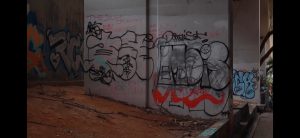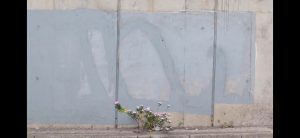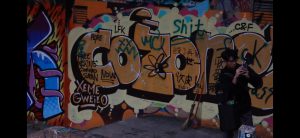5 Stills from the video:





Student name: Kwok Ka Shing 3036072762 Tse Tak Chi 3036065783
[Transcript]
Talking about graffiti, what would you think of it? Probably some scrawling or, otherwise, some sketches with special styles. In Hong Kong, of course, there is graffiti. However, it is everywhere, but also nowhere. To be precise, graffiti only exists in some alleys or some iron gates outside the stores. They are not like those commercial advertisements that usually appear in our eyes, but like treasures that are probably hiding inside every alley. In this field report, we went to “Graffiti Street,” located in Luen Wan Street, Mong Kok, near the old Water Supplies Department. This street was full of colorful and intriguing paintings. The style is mainly bold and contains lots of visual impact. However, along with the reconstruction of the Water Supplies Department, almost 80% of the original walls and paintings were being removed. Nowadays, some of the graffiti is still there just because it is on another building, not the construction site. It is expected that the existing graffiti will also be covered or cleaned in the future, as it was in the past.
This place, or every other graffiti place, serves several purposes. First, it serves as a space for people to have conversations with each other. When we take a look at the graffiti, it is not only about pictures but also words and quotes. Those words or quotes contain symbolic meanings; sometimes they are exclusionary; the audience only knows what it means when you really visit the place. Anonymous people can leave their little message or their mood at the time on the wall, and other people will reply. Just like a chatroom in real life. Also, we can see that the graffiti street itself can also interact with other spaces. For example, the words here, “Chiu Chou Public Prison” in English, describe the environment of the school, “Hong Kong and Kowloon Chiu Chow Public Association Secondary School.” Artists or audiences can have a conversation here by creating and watching. The place “Graffiti Street” can be transformed into a space for this kind of conversation.
The second meaning of such a place can also be an artistic expression. Graffiti, as a street art, itself has a certain amount of value. But in an urban city such as Hong Kong, this is usually not allowed as most of the buildings are seen as private property, and doing graffiti will be counted as “vandalizing.” On the other hand, street art is mainly about the spirit of rebelliousness and freedom. Therefore, the place then becomes the crash of the core values of rebelliousness among young people and social stability or private property rights. It is interesting to see that some graffiti on the wall is usually corrected or painted the original way, especially multiple times. When these two different values clash together, it is always difficult to determine who’s right or wrong.
In addition, the graffiti shows the fusion of different cultures. For example, here we can see the Japanese anime graffiti, Chainsaw Man. It is interesting to see that Japanese culture is showing on the back of the building. Or we can see here some local style graffiti, some American style graffiti, and some cartoon style graffiti. Through this place, cultures do not only meet, interact, and combine together, but at the same time, compete with each other to see which graffiti is the best. There is usually a graffiti culture that says that when your artwork is not that great compared to others, due to the limited space on the wall or ground, it is more likely to be covered by other artists. Competition exists, but in a good way, and excellence remains.
Unfortunately, it is expected that most of the graffiti on this street will be cleaned soon. As shown in the video, the original street was a few times longer than now, and more graffiti was being seen. However, the reconstruction of the Water Supplies Department gave a reason to the government to clear all of the graffiti, even blocking the whole street. As seen here, the original street was meant to go straight through to Argyle Street. However, most of the street is now blocked. Moreover, the original graffiti is mostly wiped out in white or gray. The graffiti we see now is newly added, and the original area of graffiti is now massively cut. Therefore, it is expected that the remaining graffiti will be cleared in the foreseeable future. For sure, it is disappointing to see this beautiful place being wiped out, especially for those who paid their time, money, and effort for their work. These graffitis take a lot of work to complete. Nonetheless, the place that allows these people to interact will all be all gone and vanished.
And to fight against this inevitable ending of this place, the only way is by expressing strong emotions through the graffiti and the space itself, leaving the message with the help of graffiti. As shown in this graffiti, “freedom” with a dollar sign inside is usually seen and is already becoming popular. It appears in a lot of places. What is the price of freedom? And what will be the consequences if this act of “vandalizing” will be vanished in 10 years? The government always said to protect and preserve culture. But the government seems not to be quite happy about this art from the street. The reconstruction of the graffiti street will be the first step to canceling this space and the whole culture within. Where will the place be for artists to voice out their own thoughts and creativity? Their desire for freedom in making art and expressing their thoughts is everywhere, and I think that there is no way to silence people by just destroying this place.